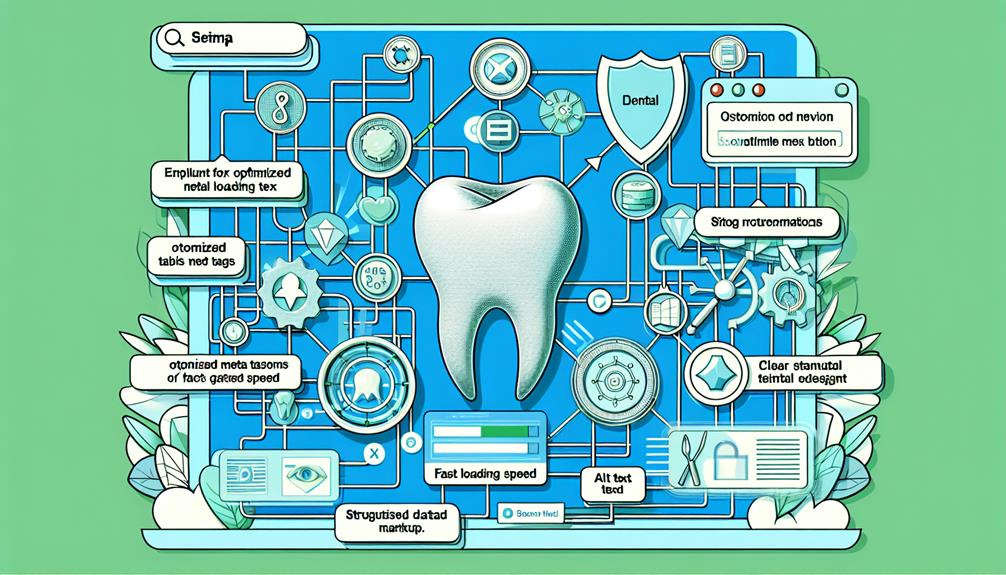When it comes to boosting your dental website’s visibility and ranking on search engines, focusing on the technical aspects of SEO is paramount.
Ensuring that your website loads quickly, is optimized for mobile devices, and utilizes schema markup are just a few of the critical elements that can significantly impact your online presence.
However, there are seven key aspects in total that you need to consider to stay ahead of the competition and attract more potential patients to your practice.
Key Takeaways
- Implement SSL certificate installation to ensure security and trustworthiness for dental websites.
- Focus on mobile-friendly design to enhance user experience and engagement for patients visiting dental websites.
- Utilize schema markup implementation to provide detailed information to search engines about dental services offered.
- Conduct regular load time analysis to optimize website speed and improve performance for seamless browsing experience on dental websites.
Website Speed Optimization
To enhance user experience and boost search engine rankings, optimizing website speed is a critical component of technical SEO for dental websites. Improving performance through load time analysis is key to ensuring visitors have a seamless browsing experience on your site. Slow-loading pages can lead to high bounce rates, negatively impacting your SEO efforts and potentially driving patients away. By conducting a thorough load time analysis, you can identify areas of improvement, such as optimizing images, leveraging browser caching, and minimizing server response times.
When it comes to website speed optimization, every second counts. Users expect fast-loading pages, and search engines favor websites that provide a smooth user experience.
By fine-tuning your site’s speed, you not only cater to your visitors’ needs but also signal to search engines that your site is reliable and user-friendly. Implementing these optimizations can have a significant impact on your search engine rankings, ultimately driving more organic traffic to your dental website.
Mobile-Friendly Design
Ensure your dental website has a responsive design to adapt effortlessly to various screen sizes, enhancing user experience and engagement.
Consider user experience aspects such as easy navigation, readable content, and accessible contact forms to cater effectively to mobile visitors.
Prioritizing mobile-friendly design not only improves SEO but also establishes credibility and trust with potential patients seeking dental services.
Responsive Design Importance
Implementing a responsive design for your dental website is crucial in ensuring optimal user experience across various devices. A responsive design adapts your site’s layout to different screen sizes, enhancing usability and accessibility. This adaptability is key in boosting your conversion rate, as visitors are more likely to engage with a site that functions well on their device.
Additionally, a responsive design contributes to the aesthetic appeal of your website, reflecting a modern and professional image to potential patients. By prioritizing responsiveness, you create a seamless browsing experience that encourages users to explore your services and contact your practice.
User Experience Considerations
Enhance user engagement and satisfaction by optimizing your dental website’s design for seamless mobile usability. When it comes to mobile-friendly design, two critical factors to focus on are navigation usability and content accessibility. Ensure that your website is easy to navigate on mobile devices, with clear menus and intuitive search functionalities. Additionally, make sure that all content, including text, images, and videos, is accessible and properly formatted for mobile viewing. By prioritizing these aspects, you can create a user-friendly experience that keeps visitors engaged and encourages them to explore your dental services further.
| Navigation Usability | Content Accessibility |
| Clear Menus | Proper Formatting |
| Intuitive Search | Accessible Text |
| Easy to Navigate | Mobile-Optimized Images |
| User-Friendly Design | Video Compatibility |
Schema Markup Implementation
When incorporating schema markup on your dental website, precision and strategic planning are key in optimizing search engine visibility and enhancing user experience. By utilizing rich snippets and enhancing structured data, you can provide search engines with detailed information about your dental practice, services, and reviews. Rich snippets help display additional information in search results, such as star ratings, reviews, and pricing, making your website more appealing to potential patients. Structured data enhancement allows search engines to better understand the content on your site, improving the chances of your pages appearing in relevant search results.
When implementing schema markup, ensure that your data is accurate, up-to-date, and relevant to your dental practice. Use schema markup to highlight essential details like your practice’s location, contact information, services offered, and customer reviews. This structured approach not only boosts your SEO efforts but also provides users with valuable information upfront, increasing the likelihood of them choosing your practice for their dental needs.
SSL Certificate Installation
To ensure the security and trustworthiness of your dental website, installing an SSL certificate is imperative. Here are some key points to consider for SSL certificate installation:
- SSL Configuration Best Practices:
- Implement strong encryption algorithms and key lengths to secure data transmission.
- Ensure that all versions of your website (www, non-www, HTTP, HTTPS) are covered by the SSL certificate.
- Regularly update SSL/TLS protocols to mitigate vulnerabilities and maintain security standards.
When setting up your SSL certificate, it’s crucial to be mindful of the Certificate Validity Period:
- Check the expiration date of the SSL certificate to prevent any downtime or security warnings on your website.
- Renew the SSL certificate before it expires to maintain uninterrupted secure connections.
- Keep track of the validity period to stay compliant with industry standards and ensure continuous protection for your dental website.
URL Structure Optimization
When optimizing your URL structure for your dental website, ensure that your URLs contain relevant keywords to improve search engine visibility.
Implement proper redirection methods to avoid broken links and maintain a seamless user experience.
These small yet crucial details can significantly impact your website’s SEO performance.
Keyword-rich URLs
Optimizing your dental website’s URL structure with keyword-rich URLs is a crucial aspect of technical SEO that enhances search engine visibility and user experience. When crafting your URLs, remember the following:
- SEO Benefits: Keyword-rich URLs can positively impact your website’s SEO performance by signaling to search engines the content of your page.
- Ranking Factors: Search engines consider the keywords in your URL when determining where your site should rank in search results.
- User-Friendly URLs: Clear and concise URLs that include relevant keywords not only benefit SEO but also make it easier for users to understand the content of the page they’re about to visit.
Proper Redirection Methods
Crafting keyword-rich URLs for your dental website not only boosts SEO performance but also sets the stage for implementing proper redirection methods to enhance user experience and search engine visibility. Utilizing 301 redirects is crucial when you have moved, deleted, or consolidated web pages. This method ensures that visitors and search engines are automatically redirected to the updated URL, preventing broken links and maintaining SEO equity.
Additionally, incorporating canonical tags helps search engines understand the preferred version of similar or duplicate content, consolidating ranking signals to the desired page. By strategically implementing these redirection methods, you can streamline website navigation, improve SEO efficiency, and provide a seamless user experience, ultimately benefiting your dental practice’s online presence.
XML Sitemap Configuration
Consider setting up your XML sitemap to ensure search engines can efficiently crawl and index your dental website’s content.
When configuring your XML sitemap, keep in mind the following key aspects:
- Organize Priority Pages: Prioritize key pages like services, contact, and blog sections to guide search engines on the importance of each page.
- Include Image and Video URLs: Enhance the indexing process by including image and video URLs in your XML sitemap to improve visibility in relevant search results.
- Regular Updates: Ensure your XML sitemap is regularly updated to reflect any changes or additions to your website, maximizing the SEO benefits and keeping search engines informed about new content.
Robots.txt File Optimization
To enhance the search engine visibility of your dental website, carefully structure and optimize your Robots.txt file. The Robots.txt file serves as a gatekeeper, directing search engine crawlers on which areas of your site to access and index. By strategically configuring this file, you can maximize your crawl budget and have better indexing control.
| Directive | Functionality | Example Usage |
| User-agent | Specify search engine bots allowed to access the site | User-agent: Googlebot |
| Disallow | Restrict search engine bots from certain areas | Disallow: /admin |
| Allow | Permit search engine bots to access specific content | Allow: /blog |
| Crawl-delay | Control the speed of the crawl rate | Crawl-delay: 5 |
| Sitemap | Indicate the location of the XML sitemap | Sitemap: https://www.yoursite.com/sitemap.xml |
Frequently Asked Questions
How Can I Improve the Visibility of My Dental Website in Local Search Results?
To boost your dental website’s visibility in local search results, focus on implementing effective Local SEO strategies. Start by optimizing your Google My Business profile with accurate information, engaging photos, and regular updates to attract more local customers.
What Are Some Best Practices for Optimizing Images on a Dental Website?
To make images shine on your dental site, compress them for speedy loading. Attach descriptive alt tags to boost accessibility and SEO. Ensure mobile responsiveness and optimize your page speed for a seamless user experience.
How Important Is It to Regularly Update Content on a Dental Website for SEO Purposes?
Regularly updating your dental website’s content is crucial for SEO rankings. Content freshness boosts user engagement and signals to search engines that your site is active and relevant. Consistent website updates are key for sustained success.
Are There Any Specific SEO Strategies That Are Unique to Dental Websites Compared to Other Industries?
When it comes to SEO strategies for dental websites, you should focus on keyword research, competitor analysis, on-page optimization, and link building. These techniques can give you a competitive edge in the industry.
What Role Does Social Media Play in the Overall SEO Strategy for a Dental Website?
In your dental website’s SEO strategy, social media serves as a powerful ally. Engage with influencers to boost visibility, and harness user-generated content for authenticity. These tactics can amplify your reach and strengthen your online presence.
Conclusion
Now that you have optimized these critical aspects of technical SEO for your dental website, get ready to see a significant improvement in your online visibility and search engine rankings.
But remember, the digital landscape is always evolving, so stay proactive and continue to monitor and adjust your SEO strategy to stay ahead of the competition. Your website’s success depends on it.
Keep refining, keep growing, and keep dominating the search results. Exciting things are on the horizon for your practice.

Suraj Rana is a renowned Dental SEO Expert, deeply committed to elevating dental practices in the online landscape. With a profound understanding of technical SEO, he specializes in tailoring on-page optimization strategies specifically for the dental industry. Suraj’s extensive experience spans across various sectors, but his passion truly lies in transforming the digital presence of dental clinics. His expertise in dental-specific search engine optimization, combined with a data-driven approach, empowers him to develop strategies that significantly increase organic traffic, enhance search engine rankings for dental-related keywords, and ultimately drive business growth for his dental clients. Suraj Rana’s unique blend of SEO skills and dedication to the dental field make him an invaluable asset to any dental practice looking to thrive online.


